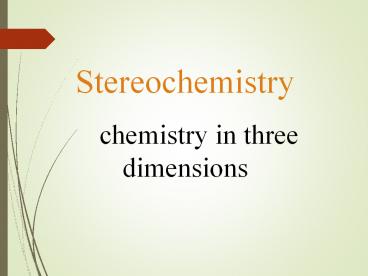Stereochemistry - PowerPoint PPT Presentation
Title:
Stereochemistry
Description:
Stereochemistry – PowerPoint PPT presentation
Number of Views:226
Learn more at:
http://www.powershow.com
Title: Stereochemistry
1
Stereochemistry chemistry in three
dimensions
2
Isomers different compounds with the same
molecular formula. Structural Isomers isomers
that differ in which atoms are bonded to which
atoms.
CH3 eg.
C4H10 CH3CH2CH2CH3 CH3CHCH
3 n-butane
isobutane
3
Stereoisomers isomers that differ in the way
the atoms are oriented in space, but not in which
atoms are bonded to which atoms. eg.
cis-2-butene trans-2-butene
4
Stereochemistry importance biochemicals m
edicine tool for studying mechanisms
5
optical activity when a substance rotates the
plane of plane polarized light. (1815 by
Biot) plane polarized light light that has
been passed through a nicol prism or other
polarizing medium so that all of the vibrations
are in the same plane.
non-polarized polarized
6
polarimeter an instrument used to measure
optical activity.
polarizer
analyzer
light source sample tube
7
dextrorotatory when the plane of polarized
light is rotated in a clockwise direction when
viewed through a polarimeter. () or (d)
do not confuse with D levorotatory
when the plane of polarized light is rotated in a
counter-clockwise direction when viewed through a
polarimeter. (-) or (l) do
not confuse with L The angle of rotation of
plane polarized light by an optically active
substance is proportional to the number of atoms
in the path of the light.
8
specific rotation the angle of rotation of
plane polarized light by a 1.00 gram per cm-3
sample in a 1 dm tube. a D (D sodium lamp,
? 589 mµ). a a D
where a observed rotation l
d l length (dm)
d concentration (g/cc) ()-alanine a D
8.5 (-)-lactic acid a D -3.8
9
Why are some substances optically active and
others not? Can we predict which ones will be
and which ones wont? Louis Pasteur (1848)
recrystallized sodium ammonium tartrate
(optically inactive). He noticed that the
crystals were of two types which he physically
separated. The two types of crystals were
optically active, but rotated the plane of
polarized light in opposite directions. He
proposed that the molecules came in two forms,
left handed and right handed. Together, the
mixture of the two forms is optically inactive.
10
enantiomers - mirror-image stereoisomers. The
physical and chemical properties of enantiomers
are identical, except 1) the direction of
rotation of the plane of plane polarized light
and 2) how they react with optically active
reagents. chiral center is a carbon that is
bonded to four different groups of atoms. (do not
confuse with chiral)
CH3CH2CHBrCH3 (CH3)2CHCH2OH
CH3CHBrCHBrCH3
11
configuration the arrangement in space of the
four different groups about a chiral center. How
do we show configurations? wedge
formulas Fischer projections cross
structures use only for chiral centers!
12
In the Fischer projection, the horizontal bonds
to the chiral center are always above the plane
and the vertical bonds to the chiral center are
below the plane. (the horizontals are hugging
you.
13
chiral not superimposeable on the mirror image
(handedness) achiral superimposeable on the
mirror image not chiral. Test for optical
activity chiral molecules are optically
active. racemic modification equimolar molar
mixture of enantiomers (will be optically
inactive) ().
14
- compounds with one chiral center will show
optical activity - compounds without chiral
centers do not normally show optical acitivity -
compounds with more than one chiral center may or
may not show optical activity depending on
whether or not they are non-superimposable on
their mirror image (chiral) or superimposable
(achiral).
15
specification of configuration The R/S
system. Cahn, Ingold, Prelog sequence
rules sequence rule 1 the atom attached to the
chiral center with the highest atomic number 1,
next 2, etc. sequence rule 2 if the four
atoms attached to the chiral center are not all
different, the sequence is determined at the
first point of difference. sequence rule 3 X
is equal to two X, etc.
16
(No Transcript)
17
THANK YOU !!!
Maruthupandi M Indian TN-MDU































